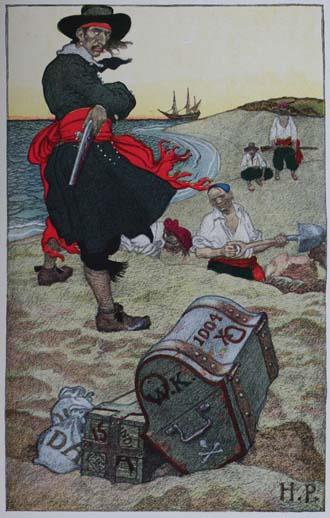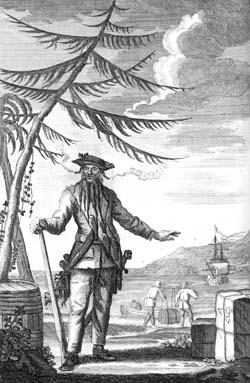Steel Clashing. Muskets firing. Cannons booming. Specters appearing through thick smoke with death in their eyes. You've not dreaming; you're under attack from the scourge of the open seas: Pirates.
When most people think of Pirates today they picture the ever memorable Captain Jack Sparrow from the motion picture Pirates of the Caribbean. You know what I mean-- the pirate bandana, the tricorn hat, loose shirt and pants with and an outer vest or pirate jacket with strapping boots. As weapons this imaginative pirate most likely has a cutlass in one hand and a flintlock pistol in the other. This idea of pirates, however, does not represent the majority of pirates throughout the ages.
Perhaps as long as people have been sailing the seas there have been people preying upon them. Some of the earliest known records of piracy are from Phoenicians well beyond 1000 BCE. The Roman Republic frequently had issues with pirates in the Mediterranean Sea. In fact, even the famed Julius Caesar spent time as a pirate prisoner. Eventually Rome had had enough and devoted entire armies to removing the problem.
During the Medieval Ages, the most common pirates were the Vikings in northern Europe. Although they preyed mostly on land settlements, the basic premise of piracy was kept alive - plunder, the driving force of all pirates throughout all ages. Far southeast of the Vikings, the various Muslim empires and Indian governments had their own piracy problems as well. The precious cargo coming from the Far East was too tantalizing a prize to resist and merchant ships were often the victims of pirate attacks. Although most of the precious spices and silk that Europe and the Middle East craved so much came from China, China itself had many problems with pirates. During the Qing dynasty, 17th - 20th century, pirate fleets grew powerful enough to rival the Qing navy!

 Blackbeard, published in 1736, Copper engraving
Blackbeard, published in 1736, Copper engraving
Pirates in the Caribbean are looked back on as glorious adventurers with a lifestyle full of excitement and danger. Piracy, however, has not died out by any stretch of the imagination. Pirates of the modern age are vicious killers, using RPGs and automatic rifles to take every kind of ship imaginable and either killing the crew outright or holding it hostage. Pirates have been a major issue for nations since the dawn of sea travel and there's little sign of things changing.
When most people think of Pirates today they picture the ever memorable Captain Jack Sparrow from the motion picture Pirates of the Caribbean. You know what I mean-- the pirate bandana, the tricorn hat, loose shirt and pants with and an outer vest or pirate jacket with strapping boots. As weapons this imaginative pirate most likely has a cutlass in one hand and a flintlock pistol in the other. This idea of pirates, however, does not represent the majority of pirates throughout the ages.
Perhaps as long as people have been sailing the seas there have been people preying upon them. Some of the earliest known records of piracy are from Phoenicians well beyond 1000 BCE. The Roman Republic frequently had issues with pirates in the Mediterranean Sea. In fact, even the famed Julius Caesar spent time as a pirate prisoner. Eventually Rome had had enough and devoted entire armies to removing the problem.
During the Medieval Ages, the most common pirates were the Vikings in northern Europe. Although they preyed mostly on land settlements, the basic premise of piracy was kept alive - plunder, the driving force of all pirates throughout all ages. Far southeast of the Vikings, the various Muslim empires and Indian governments had their own piracy problems as well. The precious cargo coming from the Far East was too tantalizing a prize to resist and merchant ships were often the victims of pirate attacks. Although most of the precious spices and silk that Europe and the Middle East craved so much came from China, China itself had many problems with pirates. During the Qing dynasty, 17th - 20th century, pirate fleets grew powerful enough to rival the Qing navy!

Still, perhaps the most well known and feared pirates of all time were those of the Caribbean. This is where the iconic image of a pirate comes from. A swashbuckler. Buccaneer. Pirate. Most active during the mid to late 1600's and the early 1700's, pirates plagued the Caribbean at sea and on land. Pirates of this age pillaged and plundered until people became afraid at the very sight of a pirate flag. Yet even in this golden age, the real pirate was very different compared to the idea that most people have of them today.
Pirate ships were some of the first and most effective true democracies since the ancient Greek city states such as Athens. Captains were elected by the crew and although mutinies did happen, if a captain didn't fit the desires of a crew they usually just voted him, or her, out. Crews often decided where the ship would go and who it would attack, not the captain. On the other hand, certain captains and pirates did stand out and became a dominating voice in the world of piracy: Blackbeard, Sir Francis Drake, Marie-Anne, Henry Morgan, Bartholomew Roberts to name a few.
Pirate ships were some of the first and most effective true democracies since the ancient Greek city states such as Athens. Captains were elected by the crew and although mutinies did happen, if a captain didn't fit the desires of a crew they usually just voted him, or her, out. Crews often decided where the ship would go and who it would attack, not the captain. On the other hand, certain captains and pirates did stand out and became a dominating voice in the world of piracy: Blackbeard, Sir Francis Drake, Marie-Anne, Henry Morgan, Bartholomew Roberts to name a few.
Blackbeard and Sir Francis Drake represent two very distinct styles of piracy. Blackbeard was a ferocious warrior with an unstoppable power in battle. He probably wore the very distinct style of pirate clothing and took an added step of putting slow burning matches under his hat to add smoke to his already terrifying appearance, making him appear like a fury from Hell. Sir Francis Drake wore wealthier, Renaissance style clothing and drank tea. Seeming more like a noble, Drake's rich appearance contrasted sharply with the pure pirate look of Blackbeard. Both men, however, are legendary for their exploits. Sir Francis Drake helped defend England from invasion by the Spanish and sunk numerous Spanish ships in the Caribbean and elsewhere. Blackbeard took dozens of ships and terrorized the sea with his fleet, directing it from his flagship Queen-Anne's-Revenge.
 Blackbeard, published in 1736, Copper engraving
Blackbeard, published in 1736, Copper engravingPirates in the Caribbean are looked back on as glorious adventurers with a lifestyle full of excitement and danger. Piracy, however, has not died out by any stretch of the imagination. Pirates of the modern age are vicious killers, using RPGs and automatic rifles to take every kind of ship imaginable and either killing the crew outright or holding it hostage. Pirates have been a major issue for nations since the dawn of sea travel and there's little sign of things changing.
by Alex Smith, MRL staff writer



